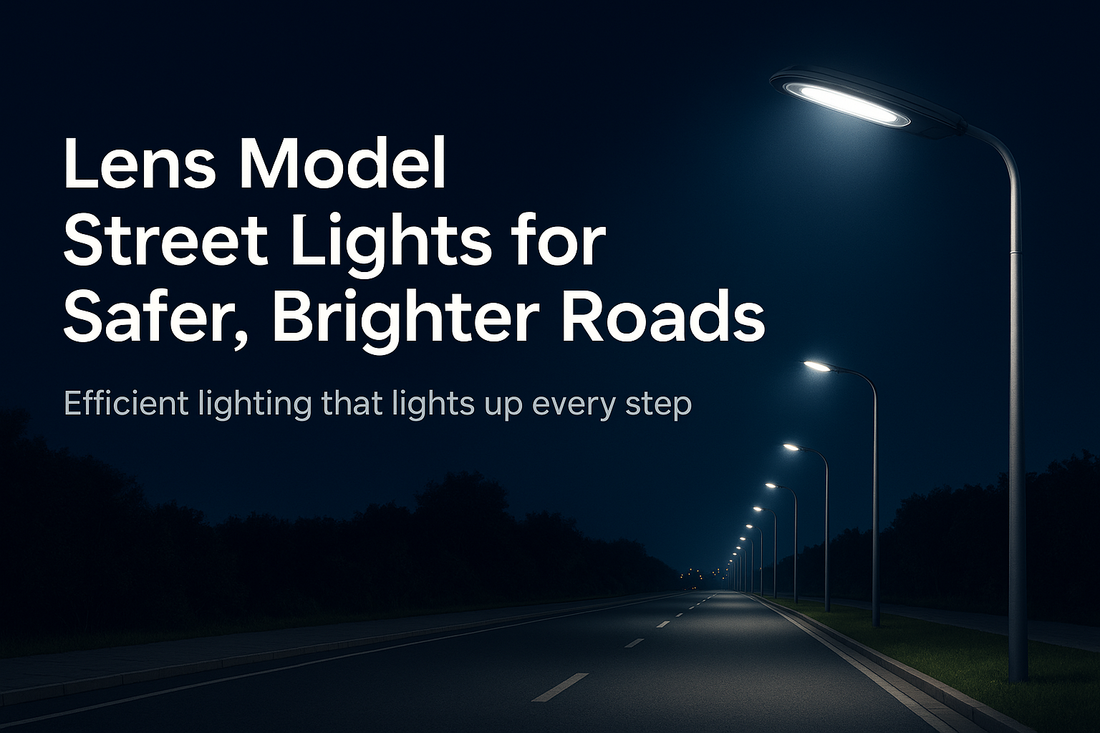
Lens Model Street Lights for Safer, Brighter Roads
Share
In modern cities, street lighting plays a vital role in safety, visibility, and aesthetic appeal. Among the latest innovations in outdoor lighting, the lens model street light stands out as one of the most efficient and advanced solutions available today. It’s a game-changer for municipal lighting, residential colonies, highways, and industrial zones.
In this comprehensive guide, we’ll explore what makes the lens model street light a superior choice, how it works, its applications, benefits, and how to choose the right one for your needs
What is a Lens Model Street Light?
A lens model street light is a type of LED street lighting system designed with precision optical lenses. These lenses control the direction, spread, and intensity of light, ensuring it is efficiently directed where it is needed the most.
Unlike traditional lights that often scatter illumination, lens model street lights provide uniform and focused lighting, reducing light pollution and energy wastage.
Why Lens Model Street Lights Are the Future
Modern urban areas need smart and sustainable lighting. Here’s why lens model street lights are rapidly becoming the standard:
1. Precision Lighting
Lens optics allow the light to be directed exactly where it’s needed—on roads, walkways, and parking spaces—minimizing waste.
2. Energy Efficiency
LEDs already consume less energy. When combined with lenses that prevent light loss, they become even more efficient.
3. Durability
Most lens model street lights are built with IP65/IP66-rated casings, making them resistant to dust, water, and harsh weather conditions.
4. Reduced Glare
Lenses diffuse harsh light and provide a smooth, consistent brightness that’s easy on the eyes.
5. Longer Lifespan
LED lens model lights can last up to 50,000 hours or more, cutting down replacement and maintenance costs.
How Lens Optics Work in Street Lighting
The lens in a lens model street light is designed to manage light in a very efficient way:
Refraction: Lenses bend the light to change its direction.
Distribution: They control the beam angle (usually 60°, 90°, or 120°) depending on the application.
Cut-off Control: Avoids lighting areas that don’t need illumination (like residential windows or trees).
This controlled lighting design is perfect for cities aiming to reduce their carbon footprint while improving nighttime visibility.
Applications of Lens Model Street Lights
Lens model street lights are versatile and can be used in various environments. Here are the most common applications:
1. Urban Streets
They provide consistent brightness that improves visibility for drivers, cyclists, and pedestrians.
2. Highways and Expressways
High-speed roads require reliable, far-reaching lighting. Lens optics ensure wide coverage without blinding glare.
3. Residential Areas
Compact and aesthetically pleasing designs make them suitable for housing societies and gated communities.
4. Industrial Zones
Factories and warehouses benefit from the robust design and efficient lighting of lens model fixtures.
5. Parking Lots and Campuses
Wide beam coverage makes them ideal for covering large open areas evenly.
Key Features to Look For in a Lens Model Street Light
If you’re considering buying or recommending a lens model street light, here are some features to evaluate:
1. Lens Material
High-quality PMMA or polycarbonate lenses offer excellent light transmission and durability.
2. LED Chip Quality
Look for brands using high-lumen, low-degradation LED chips from trusted manufacturers like Cree, Osram, or Philips.
3. Heat Sink Design
Aluminium die-cast bodies with fins ensure better heat dissipation, which prolongs the LED's life.
4. IP Rating
IP65 and above are essential for outdoor use to prevent damage from rain or dust.
5. Smart Controls
Optional features like motion sensors, dimming capabilities, or remote monitoring enhance functionality.
Installation and Maintenance
Installation Tips:
Mount at a height suitable for the beam angle and coverage area.
Ensure proper electrical grounding.
Use certified brackets and poles for safety.
Maintenance Guidelines:
Clean lenses every few months for optimal brightness.
Inspect wiring and housing for signs of wear.
Replace defective units promptly to maintain uniform lighting.
Benefits of Using Lens Model Street Lights
Here’s a quick summary of the many benefits you can expect:
Feature |
Benefit |
|
Optical Lens Design |
Targeted lighting, less light waste |
|
High Lumens/Watt |
Lower energy bills |
|
Long Lifespan |
Reduced replacement frequency |
|
IP65/IP66 Rating |
Durable in all weather |
|
Reduced Glare |
Better visibility and comfort |
|
Smart Controls Option |
Remote management and automation |
Environmental Impact and Sustainability
Cities worldwide are turning to lens model street lights not just for performance but for their positive environmental impact:
Lower CO2 Emissions: Less power usage means reduced emissions.
Eco-Friendly Materials: Many lights are made from recyclable components.
Dark Sky Compliance: Focused light minimises light pollution.
By replacing traditional sodium vapour or halogen lights with lens models, municipalities can make a big difference.
Choosing the Right Supplier
Whether you're a city planner, an architect, or a homeowner, selecting the right supplier is key:
What to Look For:
Proven track record in manufacturing LED lighting
Certifications (CE, RoHS, BIS, etc.)
Clear warranty terms (at least 2-5 years)
After-sales support and installation services
Tip: Request lighting simulations to understand beam spread and brightness before purchasing in bulk.
Future of Lens Model Street Lighting
With smart cities on the rise, the next-gen lens model street lights will likely include:
IoT Integration: Real-time data on light status, energy use, and environment.
Solar + Lens Models: Combining solar panels with optical lens efficiency.
Adaptive Lighting: Lights that change brightness based on movement and time.
FAQs
Q: What makes lens model street lights different from regular LED street lights?
A: The lens directs the light more efficiently, reducing waste and improving visibility.
Q: Are lens model street lights expensive?
A: While the initial cost may be slightly higher, the long-term energy savings and reduced maintenance make them more economical.
Q: Can I use lens model lights for residential driveways?
A: Yes, especially if you want focused lighting with minimal glare.
Q: Do these lights work with solar power?
A: Absolutely. Many solar street light systems now include lens models for better light control.
Q: How long do lens model street lights last?
A: Typically 50,000 hours or more, depending on the quality of the LED chips and heat management.
Final Thoughts
A lens model street light is more than just a lighting fixture. It represents smart urban planning, energy conservation, and enhanced public safety. With their advanced optics, long lifespan, and sleek designs, these lights are an excellent investment for modern infrastructure.
Whether you're updating city lights or designing a new layout for a commercial property, choosing lens model technology ensures you’re getting the best in performance, reliability, and sustainability.
If you're ready to take the next step in efficient urban lighting, a lens model street light is the clear choice. Brighten your streets the smart way—efficiently and beautifully.









